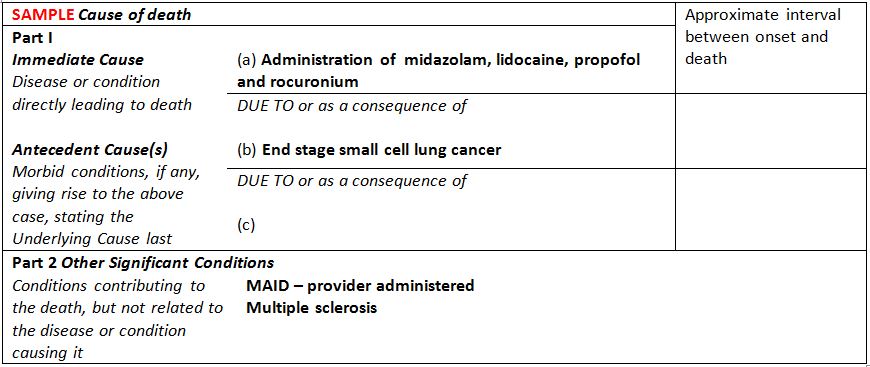Archived Guidelines for death certificates
1.0 Definitions
Terminology for death certification and reporting can vary across Canada. For the purposes of these guidelines, definitions are as follows:
- Medical assistance in dying:
- the administration of a substance by a medical practitioner or nurse practitioner to a person, at their request, that causes the person's death (provider-administered); or
- the prescription or provision of a substance by a medical practitioner or nurse practitioner to a person, at their request, for the person to self-administer to cause their own death (self-administered).
- Medical Certificate of Death: the legal record of a person’s death and its circumstances, completed at the time of death by a medical professional or other authorized person. The information collected is consistent across Canada.
- Registration of Death: a more detailed record of death containing personal information about the deceased. Non-medical information is typically obtained from the next of kin and provided by the funeral director. The format and information collected differ across provinces and territories.
2.0 Background
On June 17, 2016, An Act to amend the Criminal Code and to make related amendments to other Acts (medical assistance in dying) passed into law. Section 3.1 of the Act states, “The Minister of Health, after consultation with representatives of the provincial governments responsible for health, must establish guidelines on the information to be included on death certificates in cases where medical assistance in dying has been provided, which may include the way in which to clearly identify medical assistance in dying as the manner of death, as well as the illness, disease or disability that prompted the request for medical assistance in dying.”
In Canada, death reporting and investigation falls under the jurisdiction of individual provinces and territories. All deaths are registered by the vital statistics registrar of the province or territory in which the death occurred. Each calendar year, Statistics Canada receives a subset of this information electronically and compiles it as a part of national vital statistics for publication. Cause of death statistics are coded in accordance with the World Health Organization’s International Statistical Classification of Disease and Related Health Problems (ICD-10), and are an important source of information for public health research and surveillance. The ICD-10 does not currently contain codes for medical assistance in dying.
3.0 Purpose
These guidelines address the completion of the Medical Certificate of Death where a patient has received medical assistance in dying, to facilitate the identification of cases of medically-assisted deaths and to encourage consistency in approaches across provinces and territories.
4.0 Principles
These guidelines seek to:
- Respect the division of powers between federal, provincial, and territorial governments by serving as a non-binding reference;
- Enable the identification of cases of medically-assisted deaths, for the purpose of accurate record-keeping regarding vital statistics in Canada;
- Be consistent with the existing purposes and processes for death certification in Canada, including:
- using the World Health Organization’s ICD-10 classification system for cause of death;
- establishing an accurate record of the circumstances of death; and
- respecting the privacy of the deceased individual;
- Minimize the need for changes to current practices and procedures.
5.0 Guidelines
- Part 1 of the Medical Certificate of Death should be completed such that:
- the immediate cause is recorded in line 1a) as the toxicity of the drugs administered for the purposes of a medically-assisted death; and
- the underlying cause of death is recorded as the disease or condition that initiated the train of morbid events leading to the medically-assisted death.
- Part 2 of the Medical Certificate of Death should be completed such that:
- medical assistance in dying is recorded along with other significant conditions that may have contributed to death but were not part of the sequence of events leading to it; and
- it is specified whether medical assistance in dying was provider-administered or self-administered, in accordance with the circumstances.
- Manner of death should be certified as natural if such an option exists.
6.0 Considerations
Implications for life insurance claims: Provinces and territories should determine whether legislative/regulatory changes are needed to ensure that medical assistance in dying is not grounds for rejecting a life insurance claim.
Privacy protection: While information on the cause and manner of a person’s death is currently only available in limited circumstances, provincial and territorial governments may consider further privacy protections for patients receiving medical assistance in dying if deemed appropriate.
7.0 Example

Text Description
The image depicts how the standard template for a Medical Certificate of Death could be completed in a sample case of a person dying a medically-assisted death. The immediate cause of death, or the death or condition directly leading to death, is listed as the administration of midazolam, lidocaine, propofol and rocuronium. The antecedent cause of death giving rise to the immediate cause is listed as end stage small cell lung cancer. Other significant conditions contributing to the death, but not related to the disease or condition causing it, are listed as MAID – provider administered, and multiple sclerosis. The final column of the template, titled the approximate interval between onset and death, is left blank.